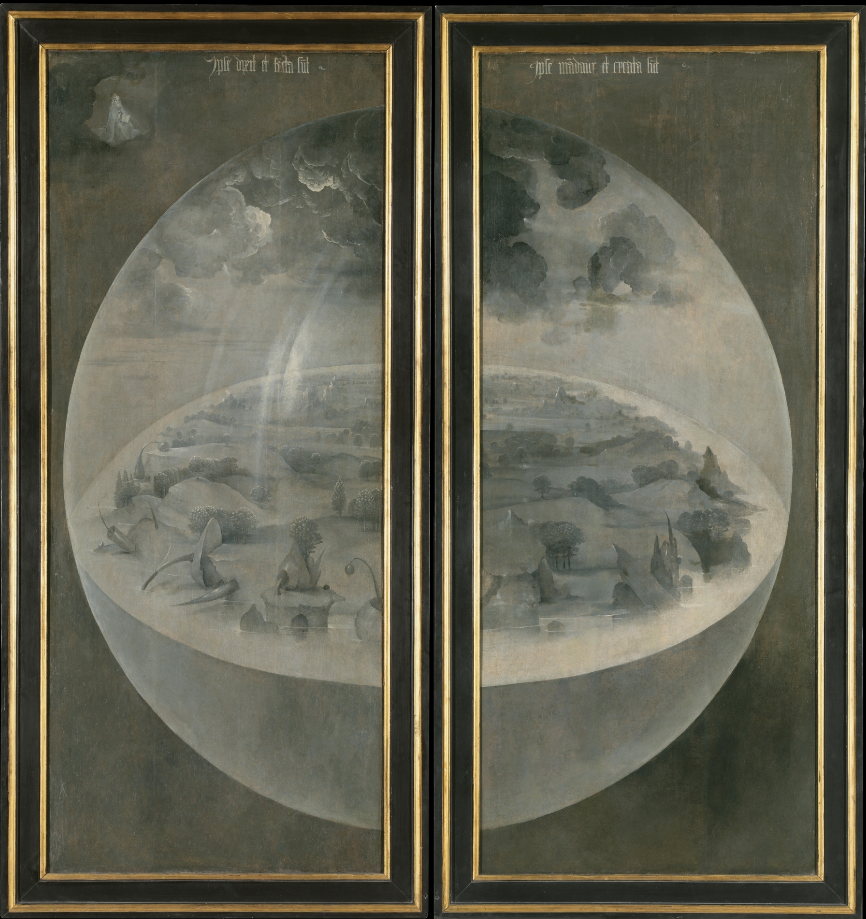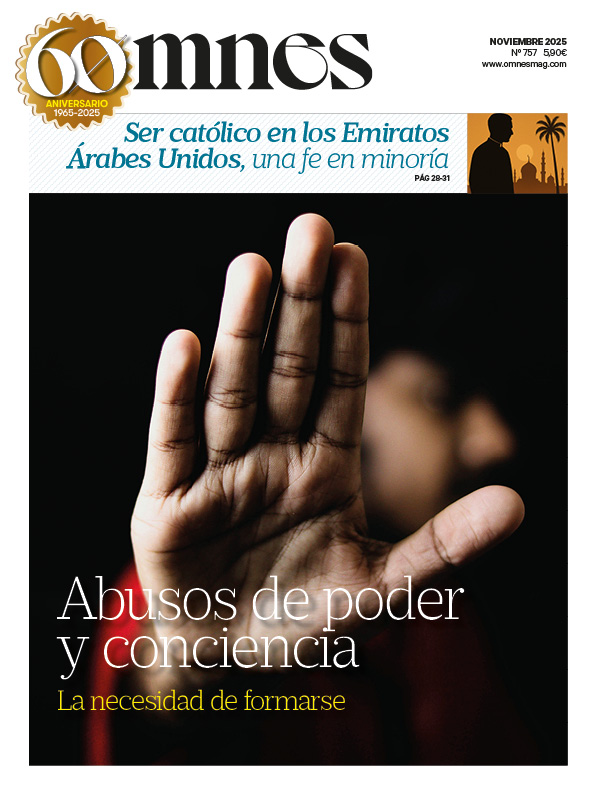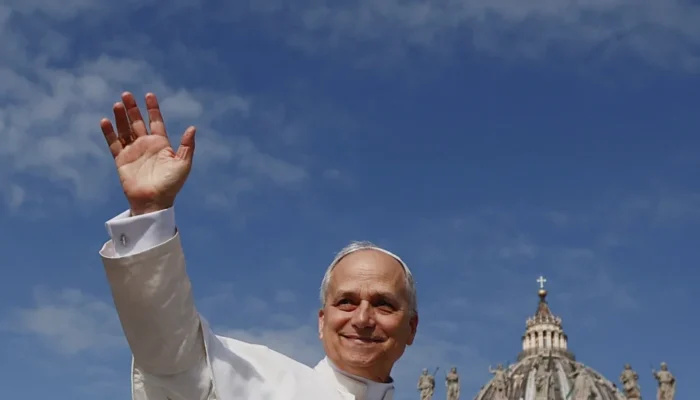This article first provides a technical explanation of The Garden of Earthly Delights by Hieronymus van Aken, exploring its composition, symbolism, and historical context. We will analyze how the painter used color, perspective, and details to create such a fascinating and complex work. In a second section, we will approach the painting from a catechetical perspective, reflecting on its spiritual and theological messages.
ARTISTIC COMMENTARY
On the third day, God created dry land, seas, plants, and trees. On the first and second days, He had already created light and the heavens.
The closed triptych shows Bosch's vision of the end of the third day of creation: a crystalline sphere floating in darkness; light and darkness are the causes of the grayish tone that reveals trees and vegetation sprouting to life, scattered across the landscape.
In the upper left corner, God is shown creating the world. At the top of both panels, the inscriptions “He said it, and it was done.” and “He commanded, and they were created.” taken from the psalms refer to his omnipotent power.
Use of the grisaille
The grayscale used is known as grisaille, whereby an image is rendered entirely in shades of gray, modeled to create the illusion of sculpture, especially relief.
This technique was popular for the outer wings of polyptychs in northern Europe in the 14th and 15th centuries. Many Italian and Flemish painters wanted to demonstrate the superiority of painting over sculpture in terms of its ability to represent three-dimensional figures, at a time when there was debate about which of the two art forms should be considered the highest in terms of realism.
The technique of grisaille helped to demonstrate that painting can trick the eye into seeing a three-dimensional form, something that cannot be said of sculpture, which cannot capture images in two dimensions. If we think about how these altarpieces looked in a church, under the light cast by candles, it is not difficult to imagine that they achieved their goal.
The creation of the world on the third day, when only light and the heavens had been created, fits perfectly with the technique used: before God created the world, there was nothing, only darkness. God created light and darkness on the first day; the sun and moon were only created on the fourth day; until that day, colors did not exist. The open triptych shows a whole range of plants and living creatures in bright colors. This vision of the earthly garden of delights would only be possible after the fourth day. The monochrome display of creation on the third day emphasizes the idea that God truly created something that was beautiful and pleasing to the eye.
Original destination of the work
Bosch painted this triptych around 1490–1500. This format was common in the Netherlands in the 14th and 15th centuries. Altarpieces of this type were usually kept closed except on special occasions. Once opened, this particular one revealed a vividly colored interior, in stark contrast to the outer wings. Unfortunately, we have lost the sense of surprise that the ritual of opening would have offered to the original viewers.
There is not much information about the exact date of execution, nor about the circumstances that led to its commission, or, more interestingly, about the place for which this painting was originally intended.
It is difficult to imagine that this triptych was commissioned to be displayed in a church, despite the religious iconography, due to the large number of nude figures inside.
The triptych was first associated with the House of Nassau: Antonio de Beatis, who accompanied Cardinal Luis de Aragón on his trip to the Netherlands, saw it in 1517 at the Nassau Palace in Coudenberg, Brussels. It was confiscated from William of Orange in 1568 by Fernando Álvarez de Toledo, Duke of Alba, and later purchased at a posthumous sale by Philip II in 1591, who sent it to the monastery of San Lorenzo de El Escorial. In 1933, it was permanently transferred to the Prado Museum.

CATECHETICAL COMMENTARY
The enigmatic grisaille contained in the two panels that close the triptych, reveals a message about Creation that we can decipher when we place it in the context of the theology and spirituality of the era in which it was conceived.
Bosch always works with symbolic elements that fill his paintings with mystery, but which become an inexhaustible source of meaning when we discover the keys behind them.
Specifically, the key to interpreting this painting can be found in a passage from the Summa Theologiae by Saint Thomas Aquinas, something obvious to those who viewed the painting in the 15th century, who knew and studied this work in depth, but not easily accessible to many contemporary viewers of this masterpiece.
In fact, in the introduction to question 65 of Part One of this work, Saint Thomas divides his exposition on material or visible Creation into three points. First, he will speak of the creative act, then of the work of the first three days of Creation (the distinction, or separation) and finally the work of the last three days (the opus ornatus, or dressing). This division finds its biblical basis in Genesis 2:1: “the heavens and the earth were completed with all their adornments”. Well, the closed triptych symbolically alludes to the first two points. When the triptych is opened, the explosion of color and movement that the viewer perceives is a powerful allusion to the third point, the opus ornatus in which God clothes the created world with animal and human life.
Let's see, then, what this wants to express to us. grisaille about the creative act, in order to later decipher its message about the first part of Creation.
The Artist and His Word
The act of creation is explained by the two passages from Scripture already mentioned, whose intense white stands out like a light of wisdom against the black background, evoking the inaccessible mystery surrounding the origin of the world and of life. The Word of God illuminates this mystery, white on black, because it is that Word that created the world. The quotation from Psalm 39 seeks to inspire meditation. It invites us to reflect on how the Word of God is the cause of all that has been received by being, and the framework that gives consistency and meaning to the world, ideas that in the New Testament refer to Jesus Christ, the Word of God, as for example in John 1:1-3 and Colossians 1:15-17.
On the other hand, the quotation from Psalm 138, a psalm that describes God's creative work in the form of a hymn of praise, inspires recognition and gratitude. For, as Bosch tries to explain, God's creative act in his Word seeks to awaken in rational creatures words of meditation and praise, since the word of these creatures is the optimal response to the Word of the Creator.
The representation of the Creator in the upper left corner seems to evoke the signature of the painter on his canvas or the sculptor on his carving. Anachronistic as this evocation may be, since we are in an era when artists rarely signed their works, it is still thought-provoking to think that the cosmos is “signed” by a Creator, who is not a product of chance or necessity but the fruit of the free and loving decision of a divine Artist, who would, incidentally, sign in the opposite corner of the painting where human artists usually do so.
Indeed, the transcendence of God, who is placed at the antipode of where the signature of a human artist would be, is also evoked by the position of the Creator in the composition. God is beyond his work, beyond time and space, inaccessible to human forces and shrouded in a mystery of darkness, because, as is also stated in the Summa, we can say more about what God is not than what God is. This expression, common among the mystics of the Netherlands who were contemporaries of Bosch, reminds us that creatures reflect the Creator, but always in a limited and imperfect way, since they are incapable of adequately representing the infinite and transcendent divine being.
The work of three days
As for the fruit of God's creative act, this grisaille already represents the first half of the year, the distinction, which, according to Genesis 1, God accomplishes in the first three days. In them, the Word of God separates opposites to prepare a suitable environment for animals and humans. On the first day, darkness is separated (distinguished) from light. So, as can be seen in the painting, the sphere that stands out against the background of darkness shines with a light that is God's first creature. On the second day, the Word of God separates the upper waters (those above the heavens, in ancient cosmology) from the lower waters (those that run over the surface of the planet).
As a boundary between them, God draws the firmament, which Bosch beautifully depicts as a crystal sphere.
On the third day, the waters below are separated from the dry land, so that a single continent groups together all the land, surrounded by the primordial sea. The Creator grants the earth the role of mother, for from it are born the various plant species that complete the preparation of the stage on which animal life will be born (the opus ornatus, from the fourth to the sixth days). Bosch's inventiveness is lavishly displayed here in a colorful representation of chimerical plant forms, suggesting the infinite inventiveness of the Creator.
All of this represents a mysterious, newly created world, full of innocence, radiant with purity, and with an admirable order designed by the Word of God. This world will be offered to human beings as a common home for all living beings, so that they, in harmony with their Creator, may care for and enjoy it. We will have to wait to open the panels of grisaille to see how this story of Creation continues and with what words human beings will respond to the Creative Word.
Work

Art historian and Doctor of Theology








